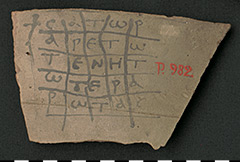P. 982
What do rabies and firefighters have to do with the film Tenet (2020)? And why is this question papyrologically relevant?
In the movie about the secret mission Tenet a Russian named Sator — founder of the company Rotas — deals with weapons, a Mr. Arepo is known as an art forger and the first scene takes place in an opera house. Rabies patients were occasionally “treated” with bread in Germany until the 18th century, into which one engraved the words sator arepo tenet opera rotas. People attempted to extinguish fires by inscribing plates with these same words, sator arepo tenet opera rotas, and throwing them into the flames.
Almost throughout the entire territory of the Roman Empire — from Pompeii to Mesopotamia — these five words can be found carved into bricks and painted on house walls. The so-called Sator formula must have been, anachronistically speaking, a viral meme.
If you write the five words one below the other, the result is a square that you can read from top left to right, bottom right to left, top left to bottom, bottom right to top. It always results in the same text. Facinating — and reason enough to leave it as graffiti on temple walls:
S A T O RA R E P OT E N E TO P E R AR O T A S
Not only in public, but also in private, such squares were diligently written down. The Berlin Papyrus Collection alone possesses several pieces from late antiquity and the early Middle Ages in which this square plays the leading role.
One of these is our item of the month: a clay shard from Egypt featuring the square (in Greek script and with a few misspellings, as usual) with a small cross painted to the left of it. Apart from that — nothing. No word about meaning, use or origin.
The Christian uses of the Sator square — as our clay shard appears to be — has always led researchers to derive religious interpretations of the 5 × 5 letters. Indeed, arranging them differently, for example as oro te pater oro te pater sanas, results in a Latin prayer to the Christian God: ‘I beseech thee, Father, I beseech thee, Father, mayst thou heal’. But also a request to the opposite religious authority slumbers in the letters: satan ter oro te reparato opes ‘Satan, three times I ask you, bring me back my treasure!’.
If you add together the letters of a certain Greek spelling of the Sator formula (the Greeks also used their letters as numbers), the result is the same as if you had added together in this way the — rather misspelled — words Ἠσοῦς Χρειστὸς Μαρίας γέννημα Θεοῦ ὑὸς σωτήρ, i.e. approximately ‘Yesus Chryst [! ], Mary’s fruit, God’s sun [!], Savior’. This, of course, cannot be a coincidence, says to the discoverer of this interpretation …
It has also been discovered that the 25 letters can be used to form a cross, which at the same time recalls the Lord’s Prayer (pater noster) and the phrase “the Alpha and the Omega” (Rev. 1:8).
P
A
A T O
E
R
P A T E R N O S T E R
O
S
A T O
E
R
For many — especially Christian — researchers, the question of the origin was clearly settled at that point. Problems arose only when Sator graffiti were discovered in Pompeii. So early, i.e. before the eruption of Vesuvius in 79 AD, the Latin version of the New Testament, from which the Lord’s Prayer and the Alpha and Omega originate, could not yet have been written. And that there were any Christians at all in a provincial town like Pompeii only about 40 years after Jesus’ crucifixion is also anything but certain.
Most Christian interpretations, moreover, confidently pass by the five words and their meaning and rush straight to the individual letters, cannot wait to put them in the “correct” order. Yet 4 of the 5 words are clearly comprehensible Latin: sator (the sower) arepo (?) tenet (holds) opera (the works) rotas (the wheels). arepo alone causes difficulties. Is it a previously unknown Latin agricultural term? Is it a name, perhaps that of the sower? Or is it only the mirroring of opera, which must stand exactly at the place, so that the symmetry works out?
If one is not satisfied with the fact that the square is nothing more than a game of letters, a quick look at the pagan religion of late antiquity will help: The conquests of Alexander the Great had already partially mixed the religions of the conquerors and the conquered Asian people. Asia Minor goddesses were imported into Greece, Assyrian deities and their temples were interpreted as Greek. Due to the great fluctuation of Roman legionaries, also Egyptian deities such as Isis later came to Italy.
Arepo could be a similar case: For this, merely the name of the Egyptian Horus child deity Harpocrates would have to be abbreviated to Harpo and written according to the late Latin pronunciation as Arepo. Since Harpocrates was worshipped as a fertility god, the name sator ‘sower’ also fits.
The overall meaning would thus be: ‘the sower Harpocrates keeps the works and wheels going’ or ‘the sower Harpocrates keeps the works or toils and (torture) wheels in check’. Both are phrases suitable for use as wishes and spells. Both phrases are wanting to be written on amulet shards and used for protection or healing.
The Egyptian god Harpocrates traveled much of the ancient world in the form of this square, leaving his mark in many places. With our item of the month, the Egyptian Sator square, the sower has, in a sense, returned home. Although his name has been lost along the way, his magic power has been preserved at least until the 18th century.



